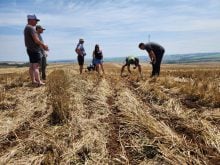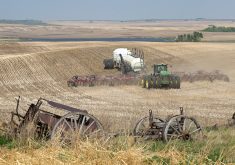CLARESHOLM, Alta. – When persistent patches of leafy spurge threatened to take over his pastures west of Claresholm, Wayne Lucas decided he needed help.
He agreed to try a targeted herbicide program and biological controls using an imported weevil on the noxious, invasive weed.
He also took some preventive steps.
“We have gone into strictly grazing and we buy our hay,” he said during a tour of his ranch. “We try to buy local hay so we don’t bring it in with other weed species we don’t want.”
Read Also

Gene editing digs deeper space in Canadian plant breeding
More Canadian research into crop variety development is incorporating gene editing, and one researcher notes that Canada’s regulatory approach to gene editing will help drive innovation
Working with agriculture fieldman Ron MacKay from the municipal district of Willow Creek, sprays like Tordon 22K were used along with the release of insects.
“At $44 a litre it is a pretty expensive chemical to use by volume so anything we can find that is different or new, we are going to try it,” said McKay.
Only spot spraying is allowed with chemicals like Tordon. As well, because the pastures drain into nearby Lyndon Creek, they wanted to prevent herbicide runoff. Insects looked like a safer alternative.
Biocontrol projects to remove troublesome invaders such as leafy spurge started about 10 years ago when Alberta municipalities worked with Agriculture Canada’s Lethbridge research centre to raise and release flea beetles to feast on the weeds.
Researchers are also looking at agents to control houndstongue, knapweed and dalmation toadflax.
Similar to weevils found on canola, the insects released in McKay’s pasture feed on weeds’ root systems at the larval stage and leave behind dried up sticks. He said he was skeptical at first but over time they seem successful.
“We started to see a real impact about two years ago, so that is when we backed out of spraying,” he said.
The plan is to encourage the bugs to build in numbers so they can be collected and moved to other infested sites.
“Just about every MD in the south region of the province is involved in biocontrol,” he said.
They release about 1,500 insects to an acre at a cost of about $1 per insect.
“In the insect world, that is not very many. They could all be wiped out in the first winter because of some environmental thing,” McKay said.
Predators imported
The predator insects were originally imported from Europe under strict quarantine. It is critical that they do not feed on native species or crops.
Insects are captured in a sweep net once a population has established itself, but there is a short time period when they can be caught.
The insects were first imported from Wyoming in co-operation with the U.S. Department of Agriculture. They were less suitable for Canadian conditions but have adapted over many generations.
Sheep grazing projects are also used but large numbers are needed.
“When you are trying to target a specific species with sheep or any other animal, you’ve got to get into a multi-year deal where the sheep will learn and start to select for it,” McKay said.
No one seems to know when leafy spurge arrived. It may have come with the Northwest Mounted Police or in hay shipments from Eastern Canada.
Alberta Agriculture estimates leafy spurge has infested nearly five million acres of rangelands and riparian areas in North America.















